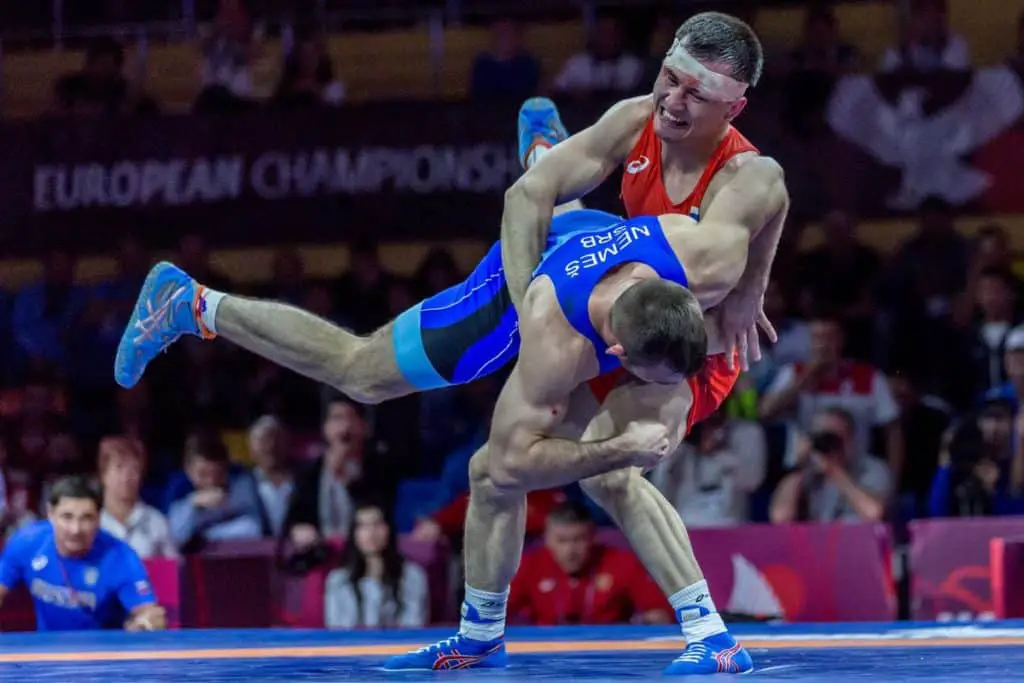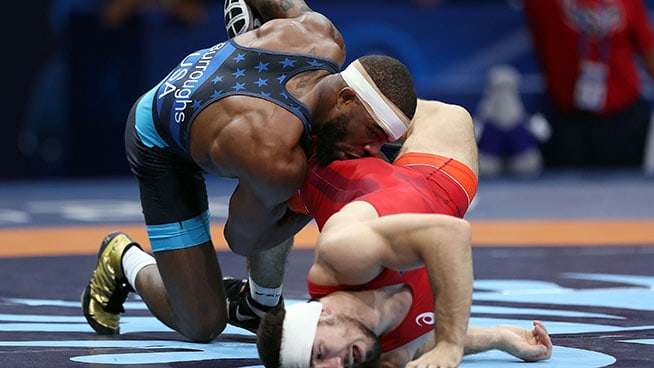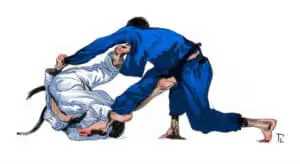
Wrestling is a brutal sport and injuries are unfortunately a common occurrence. Wrestling has a fairly high injury rate of 9.6 per 1000 athlete exposures whereas NCAA football has a lower rate of 8.1 per 1000 athlete exposures. In this article we will explain how injuries occur in wrestling and what the most common ones are.
How Do Injuries Occur In Wrestling?
Injuries occur in wrestling during a takedown when athletes fall under the body weight of their opponent. Injuries occur when wrestlers strike each other with accidental headbutts, elbows, knees. Wrestlers routinely strain their ligaments through overextending their limbs when finishing/defending takedowns.

The most common way wrestlers hurt themselves is by falling awkwardly when being takedown. Wrestlers will often be driven or slammed to the mat and land at a bad angle resulting in a twisted ankle, bruised elbow or damaged shoulder.
These injuries can be nasty if the attacking wrestler falls hard on the defending wrestler and all their body weight comes crashing down. This can result in fractures, dislocations and tears.
For example the attacking wrestler changes level and shoots a double leg takedown. The defending wrestler attempts to sprawl but it is too late and the attacking wrestling drives through taking the defender over backwards.
Unfortunately, the defending wrestler has got his leg trapped under him and ends up rolling over his ankle as the attacking wrestler falls on top of him to finish the double leg.

Another major cause of wrestling injuries is accidental strikes. Wrestlers will often hit each other with headbutts, elbows, knees and hips when fighting for position and attacking or defending against takedowns.
In the neutral position when both wrestlers are standing and fighting for inside position head clashes occur frequently. These can lead to lacerations, contusions and sometimes even concussions. Elbow strikes also happen routinely in the neutral position when wrestlers are aggressively trying to establish or break grips.
Wrestlers can also be hit with their opponent’s knee or hip when shooting takedowns. A popular way to defend against takedowns is to thrust your hips forward into the attacking wrestler as they shoot. This makes your hips feel extremely strong and often the attacking wrestler will bounce off.
If a wrestler attempts a head inside shot they can end up running directly into the defender’s very hard and sharp hip bone. The result can be a concussion, laceration or a strained neck muscle.
The same thing can happen if an attacking takes a low head inside shot and ends up running into the defender’s knee. This can result in both the attacker and defender being injured with one wrestler nursing their shoulder, arm or head while the other limping around with a damaged knee or ankle.
Wrestlers are susceptible to straining or tearing their muscles and ligaments when they become overextended when defending or attacking takedowns. The knees, shoulders, groin, ankles and back are all at risk of suffering damage.

Wrestlers often strain their shoulders when they have failed a shot and are stuck under the sprawl of the defending wrestler. In an attempt to finish the takedown or prevent a go behind they will try to hold and bring the defender’s leg in close to them.
This can cause strains and tears as the defending wrestler drives their hips backwards, while placing their whole weight on the attacking wrestler and at the same time moves to the side. This places an enormous strain on the attacker’s shoulder.
Wrestlers also routinely strain or tear their ligaments when they get into dynamic positions where they are changing direction rapidly in an effort to outmanoeuvre their opponent to score and prevent a score.
For example wrestler A may take a shot, Wrestler B then quickly circles away to avoid it, Wrestler B responds with another and manages to snatch Wrestler A’s leg, Wrestler A then explosively turns and kicks out of the single leg.
This is a common scramble in wrestling but as the wrestlers are moving so fast and at different angles at any point in that succession of movements either wrestler could injure themselves by twisting an ankle or knee.
What Are The Most Common Injuries In Wrestling?
The most common form of injuries in wrestling are skin lacerations and contusions, accounting for over 50% of injuries. 30% of wrestling sustained injuries are joint strains or muscle sprains to the neck, shoulder and knee. Over 80% of injuries occur due to direct contact between the wrestlers.

While wrestling has a high injury rate of 9.6 per 1000 athlete exposures fortunately most of the injuries are mild or light. A study of injuries during the Rio 2016 Olympics found that 54.5% of all injuries were categorized as light, 27.3% as mild and 18.2% as severe.
A study of Turkish national team wrestlers found that 57.5% of injuries resulted in the injured wrestler missing 7 or less days of training.
In the same study of Turkish national team wrestlers they found that Greco-Roman wrestlers were most likely to suffer injuries to the upper extremities (36.75%) then lower extremities (19.28%) and finally head (15.66%). While freestyle wrestlers were most likely to injure their lower extremities (40.22%) then upper extremities (31.84%) and finally head (13.41%).
Studies have shown that wrestling competitions are much more dangerous than training sessions. This is to be expected as during competitions wrestlers are competing at 100% intensity and are willing to take more risks in order to win.

The frequencies of injuries per 100h of training was 0.11. For competitions the injury frequency per 1 match was found to be 1.05.
Despite wrestling’s intensity the sport is safe with most injuries being mild and serious injuries being rare. Wrestlers are most at risk of injury when being taken down and falling awkwardly under the body weight of their opponent.
Wrestlers are likely to suffer cuts and bruises and the occasional ligament or muscle strain or tear. The back, knees, necks, elbows and shoulders are placed under a lot of stress while wrestling and are susceptible to tears, strains and dislocations.
